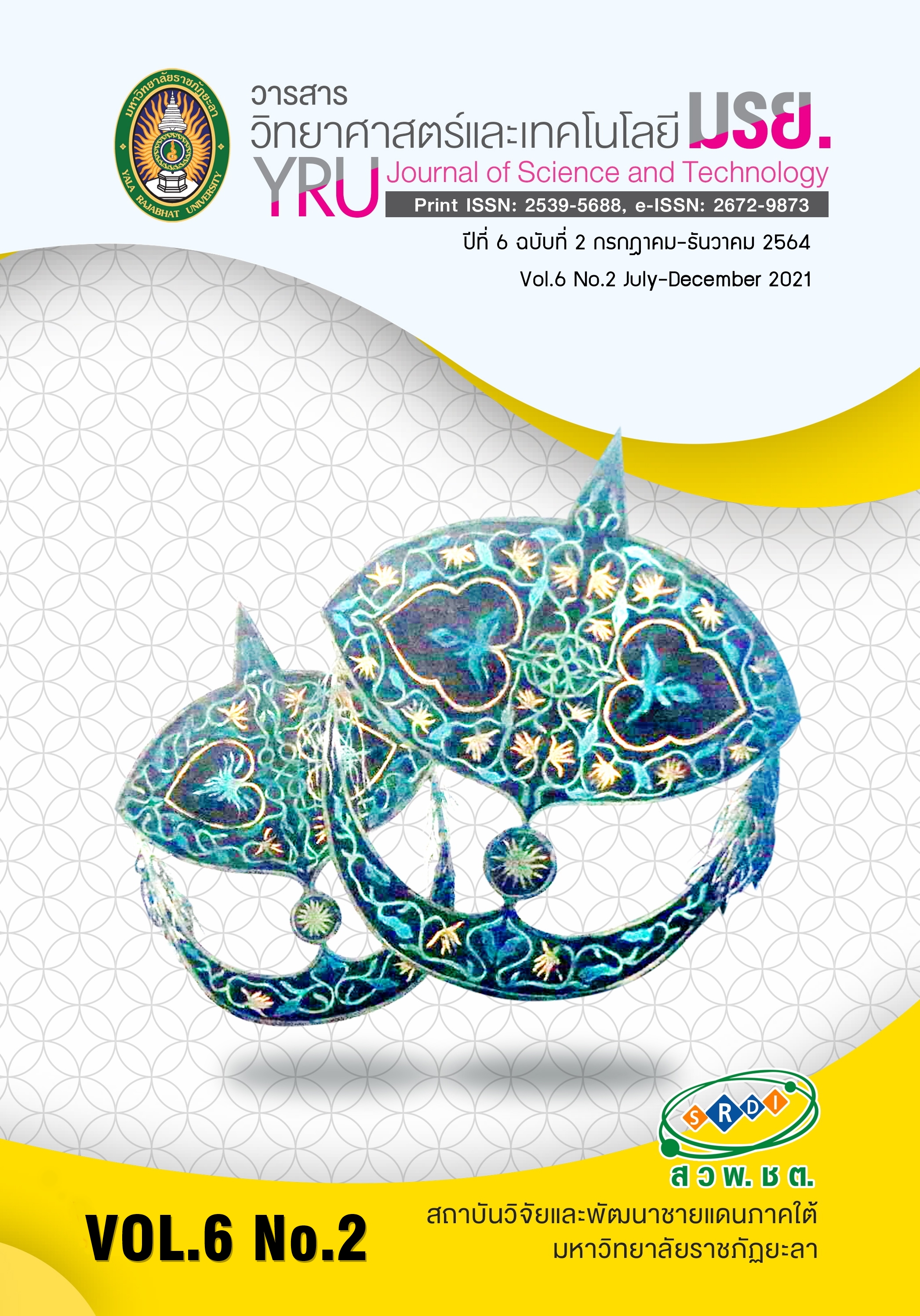การพัฒนาขนมขบเคี้ยวจากแป้งปลายข้าวไรซ์เบอร์รี่ผสมแป้งเกาลัดเสริมไลโคปีนจากมะละกอ
Main Article Content
บทคัดย่อ
ขนมขบเคี้ยวที่มีแป้งสาลีเป็นส่วนประกอบเป็นผลิตภัณฑ์ได้รับความนิยมทั่วโลก อย่างไรก็ตามยังมีกลุ่มผู้บริโภค ที่แพ้กลูเตนจากแป้งสาลี จึงต้องมีการพัฒนาผลิตภัณฑ์ชนิดปราศจากกลูเตนโดยการทดแทนแป้งสาลีด้วยแป้งปราศจากกลูเตน โดยวิจัยนี้มีวัตถุประสงค์เพื่อพัฒนาผลิตภัณฑ์ขนมขบเคี้ยวที่ปราศจากกลูเตนโดยใช้แป้งปลายข้าวไรซ์เบอร์รี่ผสมแป้งเกาลัดและนำผลิตภัณฑ์ไปเสริมคุณประโยชน์ไลโคปีนจากมะละกอสุก โดยเริ่มจากศึกษาอัตราส่วนระหว่างแป้งปลายข้าวไรซ์เบอร์รี่ต่อแป้งเกาลัด (100:0, 90:10, 80:20, 70:30, 60:40, 50:50, 40:60, 30:70, 20:80, 10:90 และ 0:100 (โดยน้ำหนัก)) ในการพัฒนาขนมขบเคี้ยว ผลการทดลองพบว่าขนมขบเคี้ยวที่ผลิตจากแป้งปลายข้าวและแป้งเกาลัดที่อัตราส่วนเท่ากับ 70:30 (โดยน้ำหนัก) มีการขยายตัวเชิงปริมาตรสูงที่สุด (ร้อยละ 54.55±0.41) ค่าความแข็งเท่ากับ 27.25±1.29 นิวตัน รวมถึงผลิตภัณฑ์ไม่มีรอยแตกหัก และได้รับคะแนนความชอบโดยรวมมากที่สุดจากผู้บริโภค จากนั้นเป็นการเสริมคุณประโยชน์ของ ไลโคปีนจากมะละกอสุกในผลิตภัณฑ์ขนมขบเคี้ยว โดยนำผลิตภัณฑ์มาเคลือบมะละกอสุกด้วยวิธีการจุ่ม นำตัวอย่างให้ ความร้อนด้วยเครื่องอบแห้งแบบถาดที่อุณหภูมิ 4 ระดับคือ 50, 60, 70 และ 80 องศาเซลเซียส เป็นระยะเวลา 5 ระดับคือ 30, 60, 90, 120 และ 150 นาที ผลการทดลองพบว่าการนำตัวอย่างอบแห้งที่อุณหภูมิ 60 องศาเซลเซียส เวลา 90 นาที สามารถรักษาปริมาณไลโคปีนในขนมได้สูงที่สุดเท่ากับ 3.08±0.05 มิลลิกรัม/กิโลกรัม ทั้งนี้ผลิตภัณฑ์ดังกล่าวควรศึกษาต้นทุนร่วมด้วย เพื่อประเมินความเป็นไปได้การในการผลิตขนมขบเคี้ยวปราศจากกลูเตนให้ตรงกับความต้องการของผู้บริโภคและตลาดในเชิงพาณิชย์มากยิ่งขึ้น
Article Details
บทความ ข้อมูล เนื้อหา รูปภาพ ฯลฯ ที่ได้รับการเผยแพร่ในวารสารวิทยาศาสตร์และเทคโนโลยี มรย. นี้ ถือเป็นลิขสิทธิ์ของวารสารวิทยาศาสตร์และเทคโนโลยี มรย. หากบุคคลหรือหน่วยงานใดต้องการนำทั้งหมดหรือส่วนหนึ่งส่วนใดไปเผยแพร่ต่อหรือกระทำการใดๆ จะต้องได้รับอนุญาตเป็นลายลักษณ์อักษรจากวารสารวิทยาศาสตร์และเทคโนโลยี มรย. ก่อนเท่านั้น
เอกสารอ้างอิง
Cooperstone, J. L., Francis, D. M. & Schwartz, S.J.(2016). Thermal Processing Differentially Affects Lycopene and Other Carotenoids in Cis-Lycopene Containing,Tangerine Tomatoes. Food Chemistry.210,466-472.
Dall’Asta, C., Cirlini, M., Morini, E., Rinaldi, M., Ganino, T. & Chiavaro, E. (2013). Effect of Chestnut Flour Supplementation on Physico-chemical Properties and Volatiles in Bread Making. LWT-Food Science and Technology, 53(1), 233–239.
Demirkesen, I. (2016). Formulation of Chestnut Cookies and their Rheological and Quality Characteristics. Journal of Food Quality, 39(4), 264-273.
Engin, D., Yahya, T. & Yusuf Y. (2013). Degradation Kinetics of Lycopene, Beta-carotene and Ascorbic Acid in Tomatoes during Hot Air Drying. Journal of food science and technology. 50(1), 172-176.
Kan, L., Li, Q., Xie, S., Hu, J., Wu, Y. & Ouyang, J. (2016). Effect of Thermal Processing on the Physicochemical Properties of Chestnut Starch and Textural Profile of Chestnut Kernel. Carbohydrate Polymers, 151, 614–623.
Littardi, P., Paciulli, M., Carini, E., Rinaldi, M., Rodolfi, M. & Chiavaro, E. (2020).Quality Evaluation of Chestnut Flour Addition on Fresh Pasta. LWT- Food Science and Technology, 126, 109303.
Mir, S., Bosco S. & Shah, M. (2019). Technological and Nutritional Properties of Gluten-free snacks Based on Brown Rice and Chestnut Flour. Journal of the Saudi Society of Agricultural Sciences, 18(1), 89-94.
Mozos, I., Stoian, D., Caraba, A., Malainer, C., Horbańczuk, J. O. & Atanasov, A. G. (2018). Lycopene and Vascular Health. Frontiers in pharmacology, 9, 1-16.
Nguyen, T. T., Le, T. Q. & Songsermpong, S. (2013). Shrimp Cassava Cracker Puffed by Microwave Technique: Effect of Moisture and Oil Content on Some Physical Characteristics. Kasetsart Journal (Natural Science), 47, 434-446.
Paciulli, M., Rinaldi, M., Cavazza, A., Ganino, T., Rodolfi, M., Chiancone, B., et al. (2018). Effect of Chestnut Flour Supplementation on Physico-chemical Properties and Oxidative Stability of Gluten-free Biscuits During Storage. LWT - Food Science and Technology, 98, 451-457.
Przybylska, S. (2020). Lycopene-a Bioactive Carotenoid Offering Multiple Health Benefits: A Review. International Journal of Food Science and Technology, 55(1), 11–32.
Schweiggert, R. M., Kopec, R. E., Villalobos-Gutierrez, M. G., Högel, J., Quesada, S., Esquivel, P., et al. (2014). Carotenoids are more Bioavailable from Papaya than from Tomato and Carrot in Humans: A Randomised Cross-over Study. British Journal of Nutrition. 111(3), 490–498.
Selani, M. M., Canniattibrazaca, S. G., Dias, C. T., Ratnayake, W. S., Flores, R. A. & Bianchini, A. (2014). Characterization and Potential Application of Pineapple Pomace in an Extruded Product for Fiber Enhancement, Food Chemstry, 163, 23-30.
Sirichokworrakit, S., Phetkhut, J. & Khommoon, A. (2015). Effect of Partial Substitution of Wheat flour with Riceberry Flour on quality of noodles, Social and Behavioral Sciences, 197(25), 1006-1012.
Sun, Q., Xing, Y., Qiu, C., & Xiong, L. (2014). The Pasting and Gel Textural Properties of Corn Starch in Glucose, Fructose and Maltose syrup. PLoS One, 9(4), e95862.
Suwanaruang, T. (2016). Analyzing Lycopene Content in Fruits. Agriculture and Agricultural Science Procedia, 11, 46-48.
Tanongkankit, Y., Narkprasom K. & Narkprasom, N. (2016). Effect of Processing on Physical Property and Carotenoid Content in Natural Food Colorant from Gac aril. Journal of Food Technology, Siam University, 11(1), 47-57. (in Thai)
Wiriyawattana, P., Suwonsichon, S. & Suwonsichon, T. (2018). Effects of Drum Drying on Physical and Antioxidant Properties of Riceberry Flour. Agriculture and Natural Resources, 52(5), 445-450.
Yadav, B. S., Yadav, R. B., Kumari, M. & Khathcar, B. S. (2014). Studies on Suitability of Wheat Flour blends with Sweet Potato, Colocasia and Water Chestnut Flours for Noodle Making. LWT-Food Science and Technology, 57(1), 352-358.


